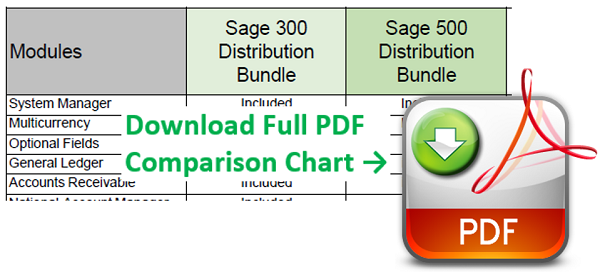Sage 300 vs. Sage 500 ERP – Time to Upgrade?
 It can be confusing comparing Sage 300 vs. Sage 500 ERP. If your company is interested in upgrading from platform-to-platform or are considering Sage ERP in general, carefully consider the capabilities of each version to make sure you are making the right decision.
It can be confusing comparing Sage 300 vs. Sage 500 ERP. If your company is interested in upgrading from platform-to-platform or are considering Sage ERP in general, carefully consider the capabilities of each version to make sure you are making the right decision.
At BrainSell, we know it’s easy to overwhelm yourself with the facts. To start, Sage 300 ERP and Sage 500 ERP are both fantastic platforms. That being said, they are separate products, so if you moved from 300 to 500 it wouldn’t necessarily be an “upgrade”, rather a platform shift. Just because Sage 500’s namesake carries a higher number, doesn’t mean that it is a better fit or a superior product to Sage 300 ERP.
We’ve even created a brand-new comparison chart fresh for 2016.
1. Sage 300 ERP / Sage 500 ERP For Financials, Distributions and Manufacturing —
Unlike Sage 300, Sage 500 is more appropriate for large-scale manufacturing companies. Both Sage 300 ERP and Sage 500 ERP have the Financials and Distributions Bundle — but only Sage 500 has the Manufacturing Bundle.
Sage 500 ERP’s “Manufacturing Bundle” includes:
- Advanced Manufacturing
- Advanced Planning and Scheduling
- Shop Floor Control
2. Payroll –
Both products carry payroll as an optional add-on product. Neither of them truly have payroll “included” in any bundle Sage offers. Payroll products can vary with Sage so be sure to ask your rep which Payroll product is right for your specific implementation.
3. Cost –
For a full pricing comparison, download our Sage 300 vs. Sage 500 ERP White Paper here. Sage 300 and 500 differ in pricing based on number of users. There are price breaks for each products depending on how many licenses you buy. The first price break for Sage 300 begins at six licenses, whereas the first price break available for Sage 500 starts when you purchase 11 licenses.
Download our Sage 300 vs. Sage 500 ERP White Paper Here
Take a detailed look at everything offered by Sage 300 Here!
4. Multi-language and Multi-currency
Both platforms support multi-language and multi-currency functionality. This is important to know especially if you are upgrading from Sage 100, which does not support either multi-lingual nor multi-currency transactions.
author bio
Sonja Fridell
Sonja is very active in architecting CRM, ERP and marketing automation solutions for clients across North America. As an ex-journalist, she is adept at exploring a client’s needs and coming up with cutting edge, elegant solutions that fit, drive adoption, and create real results.
view all articles
Stay in the Loop
Subscribe to get all our latest content sent directly to your inbox!






